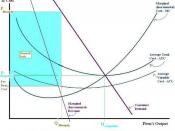At its most simplistic definition, it is easy to understand that a monopoly is the name given to a circumstance with one seller and many buyers. Then the simple theory of supply and demand is that of a market with many sellers and many buyers. An oligopoly, on the other hand, is more than one seller, but less than many sellers. It is only logical, therefore, to ask, "What is many?" What, for example, happens if there are two sellers? Though many economists suspect that the results of two sellers are more similar to those of one seller than to those of many sellers. Where then, does this leave the definition and explanation of oligopoly?
When the possession of market power is profitable, it should attract new entrants into the industry. If entry is easy, then the existence of very few or even only one firm may not result in economic inefficiency.
An oligopoly describes a market dominated by a few firms. In the world market, there are oligopolies in steel production, automobiles and semi-conductor manufacturing. But, oligopoly also describes conditions in smaller markets where a few gas stations, grocery stores or alternative burger restaurants dominate in their fields. A distinguishing characteristic of oligopoly is the interdependence of firms. An oligopoly can occur in different forms, such as, balanced and unbalanced oligopoly. The concentrated market power that may exist in oligopoly markets can be increased through mergers and acquisitions that can be horizontal or vertical. Because oligopoly is such a varied market structure, it should come as no surprise that several theories exist to explain price, output, and other factors. The motivation of an oligopolist is different than that of a monopolist or a perfect competitor. Oligopolies tend to be predatory and may sacrifice profit for a gain of market...


